Mike Morell has kindly made a Spanish translation of my Introduction to Game Time paper.
It is “Introducción al tiempo de juego / Tiempo para jugar“.
My name is Jesper Juul, and I am a Ludologist [researcher of the design, meaning, culture, and politics of games]. This is my blog on game research and other important things.
Mike Morell has kindly made a Spanish translation of my Introduction to Game Time paper.
It is “Introducción al tiempo de juego / Tiempo para jugar“.
This is my sixth monthly Patch Wednesday post where I discuss a question about video games that I think is unanswered, unexplored, or not posed yet. I will propose my own tentative ideas and invite comments.
The series is called Patch Wednesday to mark the sometimes ragtag and improvised character of video game studies.
You pick up a video game, and everything about it is just right, the fiction, the subtle variations on existing game designs, the controls. The game is a perfect match to what you think of as your very own and somewhat sophisticated taste. But something refuses to click. You are not feeling it.
This happens to me at regular intervals. For example, I think I value tight, replayable, logical, small playfield and spatial games, but I do not enjoy Threes at all. Something must be wrong with the game.
In 2010, Jason Mittell wrote a thoughtful essay on disliking Mad Men. He describes how everything seems to be stacked in favor of the show being able to win over Jason:
Mad Men is lodged squarely within my habitus: along with other cable series from channels like HBO, Showtime and FX, it’s part of the wave of “quality television” serial dramas that has raised the medium’s cultural value in the 2000s (as Lynne Joyrich discusses in this volume), and served as the object of much of my own scholarly research and personal fandom over the decade (see Mittell 2006). The show is steeped in cultural references that resonate with my own background as a media scholar, flattering my otherwise esoteric knowledge of U.S. advertising and media history. Nearly every television scholar and critic with whom I interact loves the show.
He then analyzes particular traits of the show that he finds off-putting such as the unpleasantly sexist male characters, low emphasis on empathy.
Elsewhere, Oliver Sacks and Vilayanur S. Ramachandran talk about the Capgras Delusion, where a patient is convinced that all their relatives and loved ones, even dogs, have been replaced by impostors who, the patient admits, look and act like the relative, but at the same time certainly is not that person.
Capgras syndrome is often related to brain injury, and a common interpretation is that while the patient was able to recognize faces as usual, they were unable to experience the emotional arousal that we usually experience in relation to familiar faces. Hence the experience that a person is an impostor – he or she looks like the real relative, but does not feel like the relative. The patient is not feeling it, and the relative appears alien for that very reason.
The impostor syndrome in video games
Video games: and this provides a different description of the impostor syndrome in video games (and television). We often approach a video game or some other work that ticks off all the boxes on our personal lists. We may even be invested in the aesthetic criteria on our personal list. And yet, we do not feel what we think we should be feeling. We rationally recognize the game, but our emotions fail to follow suit.
We may then send ourselves hunting for explanations, showing that the game we are playing will in some way fail to satisfy our criteria for what a good game is. This is not to discount Mittell’s discussion of Mad Men, but to point out that we often want our articulated tastes to be able to capture what we subjectively and emotionally enjoy. Whenever we feel that a particular work is an impostor, this is an incentive to find flaws in the work (the flaws may actually be there but the impetus comes from a mismatch between articulated taste and emotional response).
There are then two impostor syndromes here:
For Threes, I have been arguing for myself that I dislike Threes because I dislike the introduction of new tiles in the playfield, but is that really it? It is likely that we can never fully account for even our own tastes. We will continue to experience impostors.
I have posted a new paper, High-tech Low-tech Authenticity: The Creation of Independent Style at the Independent Games Festival.
In which I study the history of visual style in Independent Games. I look particularly at the Grand Prize winners of the Independent Games Festival (IGF) from 2000-2014. I argue that what I call Independent Style is a “representation of a representation”, using contemporary technology to emulate earlier, simpler types of representation. Examples include pixel style graphics, games made with crayons, paper, paint etc…
Interestingly, the 2000-2004 winners do not look like the style we would associate with Independent Games today. Consider Tread Marks, winner at the first IGF.
| Year | Name | Screenshot | Visual style | Theme / gameplay |
| 2000 | Tread Marks |  |
3d | Tank battle |
It is then from 2005 (with Gish) and on that the Independent Style we have come to know begins to dominate the IGF. In the paper I argue that this coincides with an increased focus on non-physical distribution as well as self-publishing.
I also claim that this Independent Style (which is the style by which we recognize independent games) is meant to signal that a small-budget production is small-budget by choice and that small-budget development has a particular authenticity and honesty.
And I also discuss the Arts and Crafts movement, texture settings in Unity, locavore food, Jeff Koons and fake wood.
All comments are welcome!
The paper was presented at the recent Foundations of Digital Games conference.
http://www.jesperjuul.net/text/independentstyle/
This is my fifth Patch Wednesday post where I discuss a question about video games that I think is unanswered, unexplored, or not posed yet. I will propose my own tentative ideas and invite comments.
The series is called Patch Wednesday to mark the sometimes ragtag and improvised character of video game studies.
What do games mean? There is a lot of good work on meaning and values in games, of course, but I think there is a very simple question that has not been fully addressed. (When I talk about “mean” here, it is primarily in the sense of a game making a normative statement about what is good/bad.)
If something is present in a game, is that a statement to the effect that what happens in the game is good and ought to be present in regular life?
Certainly, negative media commentary about video games tends to follow a very simple form, assuming that if something happens in a game (say, war), this is a ringing endorsement of war in general. In table form, it would look like this:
| This is good | |
| Event | War |
That is obviously too simple. A pro-war game will say that war is good, but an anti-war game will say that war is bad. That the endorsement view is too simple doesn’t let video games of the hook, it just means that there is more to the discussion, as there are at least two different interpretations of similar game events. The classic example is Monopoly, where the game structure was originally designed to criticize land ownership (in The Landlord’s Game), but in Monopoly this is usually interpreted as an endorsement of land ownership and capitalism. In matrix form:
| This is good | This is bad | |
| Event | Hoarding property | Hoarding property |
But there is an additional possibility. If we think of sci-fi games or any game which does not claim to represent the world as it currently is, the game can also be making statements about possible futures (say, the fight between humans and machines). It follows that a game can either say something about the current state of the world, or about a possible future (or the past). Consider the example of whether money buys political influence, and consider a game in which this is the case. This could then be taken in four different ways: Saying that 1) this is already the case (and it is bad), 2) this is already the case (and it is good), 3) this is not yet the case (and it would be bad), 4) this is not yet the case (and it would be good). (Remember that some people do believe that this is good.) This is the basic interpretation matrix:
| This is good | This is bad | |
| How it is | Money buys political influence | Money buys political influence |
| How it could be | Money buys political influence | Money buys political influence |
The very hard question, then, is how we interpret a particular game such as Grand Theft Auto V. I may have sometimes been too keen on making the “it’s more complicated than that”-argument and leaving it at that. So let’s go on.
The enjoyment of bad things
The problem with GTA V probably is that while it on some level can be seen as making social commentary about violence, race, gender, and politics, arguably placing it in the how it is / this is bad square (given that all characters are anti-heroes), it just does that in an uncomfortably leery, consistent and celebratory fashion. So the interpretation matrix is rather like this, where the game at least part of the time seems to be signaling the right thing, but that it is hard not to feel that there is a voice in the game screaming “AWESOME!” at the in-game violence, sexism and racism. Matrix:
| This is good | This is bad | |
| How it is | GTA V world | GTA V world (“IT’S ALSO AWESOME!“) |
| How it could be | GTA V world | GTA V world |
This doesn’t quite end it though. In reception studies (say Janet Staiger’s Perverse Spectators) one discussion concerns what we can call interpretation-by-proxy. I.e. “I am a good person with all the right morals, critical faculties and so on, but the actual audience for this movie/game/book obviously lacks these qualities and will be brainwashed and interpret things very differently. And I will make judgments based on my prejudices about that naive audience “.
What we can say about GTA V is that a suspicious amount of energy and care has gone into making a particular game world with events that we would at any time say we are against, but which are also meant to be enjoyable (in a broad sense) when we play the game. Of course, this is a criticism to be leveled at any kind of art or discussion about unpleasant subjects – that they end up aestheticizing what they are supposed to be against. (See also the PPPS below.)
So how can we tell if there is such an “AWESOME!” model player of GTA V, and that it isn’t just us being prejudiced about a game audience in the same way that academics have traditionally been prejudiced about the television, romance novel, game audiences? The short answer is that we cannot simply assume that we are personally superior to the imagined audience of a given game/movie/novel.
In the end, then, I think the problem with GTA V is that it seem to show too much love for its own present/dystopian world. And this is what makes us skeptic about the meaning of the game; about what value the game is assigning to its content.
This is what the interpretation matrix is for: by looking at the meaning of a game as an interpretation matrix, we can to take a step back and think more broadly about possible, and sometimes conflicting, meanings.
***********
PS. I don’t think I have seen these interpretation matrices before, but it seems like an obvious idea, so I may be wrong.
PPS. In A Year with Swollen Appendices, Brian Eno describes the impossible futures-game, where participants have to describe futures that can never take place. One example is people with different astrological signs waging war against each other. This is the “how it could not possibly be”-variation, which is quite rare.
PPPS. Susan Feagin talks about (“The Pleasures of Tragedy“) that we may enjoy tragedy for the fact that it makes us feel good about our own moral standing, “We find ourselves to be the kind of people who respond negatively to villainy, treachery, and injustice. This discovery, or reminder, is something which, quite justly, yields satisfaction.” We probably associate this with the too keen and PR-minded celebrity who is into good causes, but of course it could also be that we are like that ourselves. In matrix form:
| This is good | This is bad | |
| How it is | Violence | Violence (“This belief makes me a good person!”) |
| How it could be | Violence | Violence |
This is my fourth Patch Wednesday post where I discuss a question about video games that I think is unanswered, unexplored, or simply not posed yet. I will propose my own tentative ideas, and invite comments.
The header sounds a bit like Ash Wednesday, so we can reaffirm our faith in the idea of examining video games, but Patch Wednesday to mark the sometimes ragtag and improvised character of video game studies.
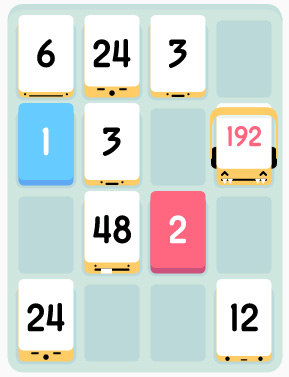
Where did Threes come from? The currently massively popular puzzle game Threes is seen as the victim of a large number of clones, particularly 2048. To prove their point, the developers have posted a long article explaining their design process.
At the same time, though 2048 is in many ways similar to Threes, some people also whisper that they think 2048 is the better game, because it is simpler (always doubling 2, 4, 8 rather than the 1+2=3 merging of Threes). It certainly is more intuitive to a programming mind.
Life is not fair, of course, and it seems a shame that someone can borrow from the game that someone else developed and through a minor change reap the seeds of the iterative design process of someone else. But you cannot copyright game ideas, only their expression.
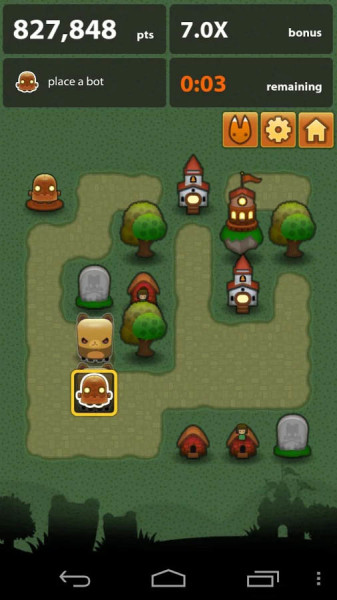
Regardless, where does Threes come from? As a headline, the game contains two particular and rare mechanics: merging (the combination of objects to form higher-level objects) and slide-to-combine (pushing the entire screen to one side at a time, combining objects that are pushed into each other).
1) Merging
The merging mechanic does at this time seem to be inspired by Triple Town, where merging is reminiscent of match-three games. Yet where regular match-three matches lead to clearing the objects matched, Triple Town matches always creates a new higher-level object.
But where does this merging mechanic come from? Dan Cook, triple town developer stated that it was inspired by the idea of sets in card games as well as by crafting systems.
Quick research and the twittersphere proposed a few sources for merging:
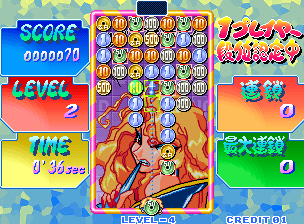 The king in Checkers – but this is not what I meant, since the stacking of two pieces is just a convenient way to signal a special piece, rather than an element of the gameplay. So merging is to be understood in a gameplay-sense.
The king in Checkers – but this is not what I meant, since the stacking of two pieces is just a convenient way to signal a special piece, rather than an element of the gameplay. So merging is to be understood in a gameplay-sense.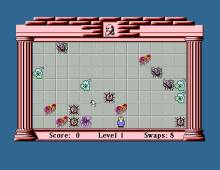 New winner (thanks to Marc Majcher): the 1990 Darwin’s Dilemma.
New winner (thanks to Marc Majcher): the 1990 Darwin’s Dilemma.I am sure I have missed something here (let me know). Until I came upon Cassino (which I played as a child), I was entertaining the theory that merging is simpler to do in digital form, and therefore was rare in analog games, but this theory is probably wrong.
2) Slide to combine
(Winner) T![DBTPlay07[1]](http://www.jesperjuul.net/ludologist/wp-content/uploads/2014/04/DBTPlay071.jpg) his was easy: I immediately recognized the slide to combine control of Denki Blocks (2001). In Denki Blocks, objects don’t merge to occupy a shared space, but rather become stuck to each other.
his was easy: I immediately recognized the slide to combine control of Denki Blocks (2001). In Denki Blocks, objects don’t merge to occupy a shared space, but rather become stuck to each other.
Is there an earlier one?
What we’ve learned
The “first game to x” is not be as simple as it sounds. In this case, the concept of merging had to be defined more clearly before I could start tracing it. Slide to combine only had one obvious candidate.
Finding the “first” is very hard, since you can never prove your argument, only hope not to be disproved.
Note that the Threes developers have (as far as I know) not mentioned any of the games I have cited as sources for merging and sliding. I think some of this is due to a particular mechanic simply being “in the air”, and some of it may be parallel invention. In many cases, we will never know.
Games are made out of bits of other games, people!
Thanks
To Eric Zimmerman, Frank Lantz, Dan Cook, Alexandre Houdent, Aaron Isaksen, Bruce Boyden, Mikkel Faurholm, Clay Branch, Matthijs Holter, Marc Majcher.
Transactions of the Digital Games Research Association has published Vol 1, No 2 (2014). This is a special Issue, with selected articles from Nordic DIGRA 2012.
| Introduction: Exploring Nordic Game Research | HTML PDF |
| Raine Koskimaa, Frans Mäyrä, Jaakko Suominen |
| Digital Materialities and Family Practices: The Gendered, Practical, Aesthetical and Technological Domestication of Play | HTML PDF |
| Jessica Enevold |
| Player Types: A Meta-synthesis | HTML PDF |
| Juho Hamari, Janne Tuunanen |
| Player-reported Impediments to Game-based Learning | HTML PDF |
| J. Tuomas Harviainen, Timo Lainema, Eeli Saarinen |
| A Practical Guide to Using Digital Games as an Experiment Stimulus | HTML PDF |
| Simon Järvelä, Inger Ekman, J. Matias Kivikangas, Niklas Ravaja |
| Should I stay or should I go? A Study of Pickup Groups in Left 4 Dead 2 | HTML PDF |
| Jonas Linderoth, Staffan Björk, Camilla Olsson |
| In Defence of a Magic Circle: The Social, Mental and Cultural Boundaries of Play | HTML PDF |
| Jaakko Stenros |
This is my third Patch Wednesday post where I discuss a question about video games that I think is unanswered, unexplored, or simply not posed yet. I will propose my own tentative ideas, and invite comments.
The header does sound a bit like Ash Wednesday, so we can reaffirm our faith in the idea of examining video games, but I also call it Patch Wednesday to mark the sometimes ragtag and improvised character of video game studies. It falls mostly on the day after Microsoft’s monthly Patch Tuesday. Time to patch things up and start again.
I think it by now is well understood that players approach a new game on the basis of their previous game (and other) experiences – hence the success of casual games that can be approached by a new audience. And we understand that players during a game will expand their skill set gradually (what I call repertoire in Half-real).
OK, but can we extend this outside regular game-play?
I thought of this when last year, Richard Bartle posted this brain teaser from the “Daily Brain Games” calendar:
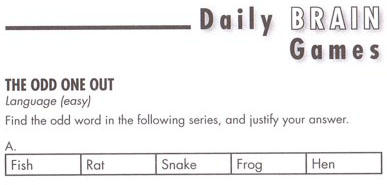
What is the right answer? Bartle proposed the following:
The calendar wants us to answer rat, because it is a mammal. I have posed this riddle to several people who can instantly identify the correct answer, while I struggled to choose between all the possible explanations I could come up with. I couldn’t figure out why at first, but I suspect that we can identify a number of genre conventions that govern how you are meant to approach such puzzles. For anything related to the natural world, I think there is a hierarchy where you are supposed to answer according to the first distinction applicable:
1) Natural / man-made
2) Fly / walk two legs / walk four legs / swim
3) Mammals / non-mammals
4) Nocturnal / diurnal
5) Cold-blooded / warm-blooded
… 23) Shed skin … 26) Extinction status … 48) Funny observations about the spelling … and so on.
So the trick is to approach a question like this not as logic, but as “what are the usual answers in this genre”.
I find that the word and visual puzzles in IQ test often have a similar quality: it is easy to conjure up dozens of possible answers and explanations (like this one), but the test creators seem to believe that there really is one true answer. And again, it comes down to a set of genre conventions that have built over the years.
Another example concerns the kind of puzzles posed to show that humans have a poor grasp of probability or logic. I discussed the Tuesday boy problem some time ago, but let us take the simpler Boy or girl paradox.
If you are into probability puzzles, you assume that there is something particular to look out for in the phrasing of the question, and yes: you understand that the question concerns the likelihood that someone who has two children and more than zero boys, will have two boys. The correct answer is 1/3. (Because there are three boy/girl combinations with more than zero boys: boy/girl, girl/boy, boy/boy, and only one of these is boy/boy, so the answer is 1/3.)
If you are not into probability puzzles, you imagine a situation where you meet someone with one of their children, a boy, and you are asked about the likelihood that the other child is also a boy, so 1/2. This certainly isn’t the answer you are meant to give.
It is undoubtedly true that we often apply too-simple heuristics to problems like this, but it is also clear that Boy or Girl Paradox may be more of a test of whether we are into probability puzzles than of whether we intuitively understand probability.
Compare this to the Monty Hall problem, which does not seem to be based on genre knowledge, but actual questions of probability.
I don’t mean to suggest that everything is a game, only that IQ tests and some probability puzzles are too much like stale and ossified game genres to actually measure that they are meant to measure.
As for game studies, I think this shows how the tools that we have developed for game design and game play – these tools can become useful outside regular games.
The Heidelberg Journal of Religions on the Internet has launched a special issue on Religion in Digital Games. Multiperspective and Interdisciplinary Approaches.
Complete Edition of “Religion in Digital Games” (Online – Heidelberg Journal of Religions on the Internet) PDF
Simone Heidbrink (ed.), Tobias Knoll (ed.)
Let’s Talk Video Games! Introduction to the Special Issue on Religion in Digital Games PDF
Simone Heidbrink, Tobias Knoll
Theorizing Religion in Digital Games. Perspectives and Approaches PDF
Simone Heidbrink, Tobias Knoll, Jan Wysocki
Studying Religion in Digital Gaming. A Critical Review of an Emerging Field PDF
Gregory Price Grieve, Heidi A. Campbell
Developing a Framework for Understanding the Relationship Between Religion and Videogames PDF
Richard E. Ferdig
Locating the Locus of Study on “Religion” in Video Games PDF
J.D.F. Tuckett, David G. Robertson
Game Cultures as Sub-Creations. Case Studies on Religion & Digital Play PDF
Elke Hemminger
Maker’s Breath. Religion, Magic, and the ‘Godless’ World of BioWare’s Dragon Age II (2011) PDF
Kristin M.S. Bezio
‘The Lamb of Comstock’. Dystopia and Religion in Video Games PDF
Frank G. Bosman
Religion as Resource in Digital Games PDF
Ryan Clark Thames
‘When people pray, a god is born… This god is you!’ An Introduction to Religion and God in Digital Games PDF
Markus Wiemker, Jan Wysocki
The Lord is My Shepard. Confronting Religion in the Mass Effect Trilogy PDF
Joshua A. Irizarry, Ita T. Irizarry
Religion(s) in Videogames. Historical and Anthropological Observations PDF
Alessandro Testa
Socialization of Teenagers Playing The Sims. The Paradoxical Use of Video Games to Re-enchant Life PDF
Pascaline Lorentz
Fátima Postmortem PDF
Luís Lucas Pereira, Licínio Roque
The Mythic Scope of Journey. A Comparative Assessment Concerning the Spirit at Play and Cybernetic Shamanism PDF
Robert William Guyker
Review: „eGods. Faith versus fantasy in computer gaming“ PDF
Moritz Maurer